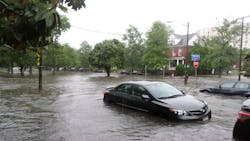US coastline to see up to a foot of sea level rise by 2050
Yesterday, the National Oceanic and Atmospheric Administration (NOAA), with the release of its new Sea Level Rise Technical Report, estimated that sea levels could rise by up to a foot by 2050.
The Sea Level Rise Technical Report provides the most up-to-date sea level rise projections for all United States territories by decade for the next 100 years and beyond, based on a combination of tide gauge and satellite observations and all the model ensembles from the Sixth Assessment Report of the Intergovernmental Panel on Climate Change (IPCC).
The report projects sea levels along the coastline will rise an additional 10-12 inches by 2050 with specific amounts varying regionally. This means that the U.S. is expected to experience as much sea level rise by the year 2050 as it witnessed in the previous hundred years.
The report updates the federal government’s 2017 sea level rise projections, and provides additional information on tide, wind, and storm-driven extreme water levels affecting current and future coastal flood risk. A suite of federal tools will begin using this data, including the NOAA Sea Level Rise Viewer.
“For businesses along the coast, knowing what to expect and how to plan for the future is critical,” said U.S. Secretary of Commerce Gina M. Raimondo. “These updated projections will help businesses, and the communities they support, understand risks and make smart investments in the years ahead.”
The report also finds that the sea level rise expected by 2050 will create a profound increase in the frequency of coastal flooding, even in the absence of storms or heavy rainfall.
“By 2050, moderate flooding — which is typically disruptive and damaging by today’s weather, sea level and infrastructure standards — is expected to occur more than 10 times as often as it does today,” said Nicole LeBoeuf, NOAA National Ocean Service Director. “These numbers mean a change from a single event every 2-5 years to multiple events each year, in some places.”
“This is a global wake-up call and gives Americans the information needed to act now to best position ourselves for the future,” said Rick Spinrad, Ph.D., NOAA Administrator. “As we build a Climate Ready Nation, these updated data can inform coastal communities and others about current and future vulnerabilities in the face of climate change and help them make smart decisions to keep people and property safe over the long run.”
Read the Sea Level Rise Technical Report here.
Increasingly, coastal states — including Louisiana, North Carolina, South Carolina, Virginia and New Jersey — are releasing Coastal Resilience Master Plans to address long-term flood risks.
Thanks to the Infrastructure Investment and Jobs Act, federal adaptation funding for FEMA programs like Building Resilience Infrastructure and Communities (BRIC) will triple over the next five years. The most recent BRIC grant cycle received a record-setting $4.16 billion in applications from states, tribes, and territories for initiatives that build resilience to flooding and other natural hazards.


